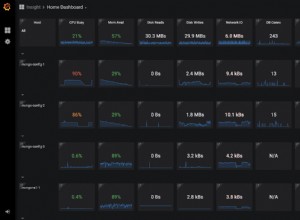Jedynym sposobem, aby to zrobić, jest użycie tablicy kontrolnej kodu...
create table code_control
(year number(4,0) not null
, type varchar2(1) not null
, last_number number(38,0) default 1 not null
, primary key (year,type)
)
organization index
/
... który jest utrzymywany w ten sposób ...
create or replace function get_next_number
(p_year in number, p_type in varchar2)
return number
is
pragma autonomous_transaction;
cursor cur_cc is
select last_number + 1
from code_control cc
where cc.year= p_year
and cc.type = p_type
for update of last_number;
next_number number;
begin
open cur_cc;
fetch cur_cc into next_number;
if cur_cc%found then
update code_control
set last_number = next_number
where current of cur_cc;
else
insert into code_control (year,type)
values (p_year, p_type)
returning last_number into next_number;
end if;
commit;
return next_number;
end;
/
Ważną rzeczą jest WYBIERZ... DO AKTUALIZACJI. Pesymistyczne blokowanie gwarantuje wyjątkowość w środowisku wielu użytkowników. PRAGMA zapewnia utrzymanie code_control nie zanieczyszcza szerszej transakcji. Pozwala na wywołanie funkcji w wyzwalaczu bez zakleszczeń.
Oto tabela z kluczem takim jak twój:
create table t42
(year number(4,0) not null
, type varchar2(1) not null
, id number(38,0)
, primary key (year,type, id)
)
/
create or replace trigger t42_trg
before insert on t42 for each row
begin
:new.id := get_next_number(:new.year, :new.type);
end;
/
Nie mam nic w rękawie, zanim wypełnię t42 :
SQL> select * from code_control;
no rows selected
SQL> select * from t42;
no rows selected
SQL> insert into t42 (year, type) values (2016, 'A');
1 row created.
SQL> insert into t42 (year, type) values (2016, 'A');
1 row created.
SQL> insert into t42 (year, type) values (2016, 'A');
1 row created.
SQL> insert into t42 (year, type) values (2016, 'B');
1 row created.
SQL> insert into t42 (year, type) values (2016, 'A');
1 row created.
SQL> insert into t42 (year, type) values (2017, 'A');
1 row created.
SQL> select * from t42;
YEAR T ID
---------- - ----------
2016 A 1
2016 A 2
2016 A 3
2016 A 4
2016 B 1
2017 A 1
6 rows selected.
SQL> select * from code_control;
YEAR T LAST_NUMBER
---------- - -----------
2016 A 4
2016 B 1
2017 A 1
SQL>
Oczywistym zarzutem wobec tej implementacji jest więc skalowalność. Transakcje wstawiane są serializowane na code_control stół. To absolutnie prawda. Jednak blokada jest utrzymywana przez najkrótszy możliwy czas, więc nie powinno to stanowić problemu, nawet jeśli t42 tabela jest wypełniana wiele razy na sekundę.
Jeśli jednak stół jest poddawany ogromnej liczbie równoczesnych wstawek, blokowanie może stać się problemem. Bardzo ważne jest, aby stół posiadał wystarczającą ilość slotów na Zainteresowane Transakcje (INITRANS, MAXTRANS), aby poradzić sobie z jednoczesnymi wymaganiami. Ale bardzo obciążone systemy mogą wymagać inteligentniejszej implementacji (być może generowania identyfikatorów w partiach); w przeciwnym razie zrezygnuj z klucza złożonego na rzecz sekwencji (ponieważ sekwencje skalują się w środowiskach wielu użytkowników).




